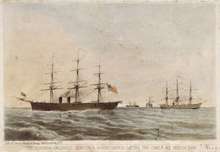HMS Valorous (1851)
HMS Valorous was a 16-gun, steam-powered paddle frigate of the Royal Navy built at Pembroke Dockyard and launched on 30 April 1851.
.jpg) HMS Valorous, a sketch by W L Wyllie | |
| History | |
|---|---|
| Name: | HMS Valorous |
| Ordered: | 25 April 1847 |
| Builder: | Pembroke Dockyard/Miller & Ravenhill |
| Laid down: | March 1849 |
| Launched: | 30 April 1851 |
| Completed: | 7 July 1853 |
| Fate: | Sold for breaking up 27 February 1891 |
| General characteristics | |
| Class and type: | Magicienne-class second-class paddle frigate |
| Tons burthen: | 1,255 bm |
| Length: | 210 ft (64 m) |
| Beam: | 36 ft (11 m) |
| Draught: | 24 ft 6 in (7.47 m) |
| Propulsion: | |
| Speed: | 9–10 knots (17–19 km/h; 10–12 mph) |
| Complement: | 175 |
| Armament: |
|
| Notes: | Displaced 2,300 tons |
Design and construction
She was part of the two-ship class of Magicienne-class second-class paddle frigates. She was built at a cost of £69,064, of which her machinery cost £24,329.[1] She was originally ordered on 25 April 1847[1] as a first-class sloop to John Edye's design, approved on 12 August 1847. On 5 August 1847 they were re-ordered as 210 ft (64 m) vessels. When finished, they constituted the last group of paddle warships built for the Royal Navy.

Career
In 1852 she was in the Mediterranean Sea, then in 1854 she was assigned to the Baltic Sea .[2] On 23 July, Valorous ran aground in the Åland Islands, Grand Duchy of Finland. She was severely damaged, losing her forefoot and keel and being holed. A sail was placed over the hole and her crew managed to prevent her from sinking.[3] In 1855 she operated in the Black Sea during the Crimean War. In 1857 she was on the North America and West Indies Station, and from 1863 until she was paid off in September 1867 she operated off the Cape of Good Hope. Carrying extra stores, she accompanied the British Arctic Expedition ships Alert and Discovery as far as Godhavn in 1875.[4] In 1878 she was commanded by Captain John A Fisher (later Admiral of the Fleet).[2]
Footnotes
- Winfield, R.; Lyon, D. (2004). The Sail and Steam Navy List: All the Ships of the Royal Navy 1815–1889. London: Chatham Publishing. ISBN 978-1-86176-032-6.
- Mackay pp. 138–139
- "The Baltic Fleet". The Times (21812). London. 1 August 1854. col E-F, p. 10.
- Mills, William James (2003). Exploring Polar Frontiers: A Historical Encyclopedia. ABC-CLIO. ISBN 978-1-57607-422-0.
References
- Colledge, J. J.; Warlow, Ben (2006) [1969]. Ships of the Royal Navy: The Complete Record of all Fighting Ships of the Royal Navy (Rev. ed.). London: Chatham Publishing. ISBN 978-1-86176-281-8.
- Lyon, David & Winfield, Rif (2004). The Sail and Steam Navy List, All the Ships of the Royal Navy 1815–1889. Chatham. ISBN 1-86176-032-9.
- Mackay, Ruddock F. (1973). Fisher of Kilverstone. London: Oxford University Press.